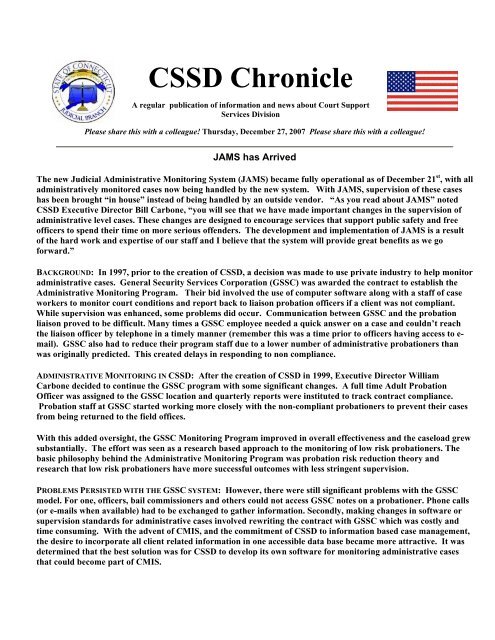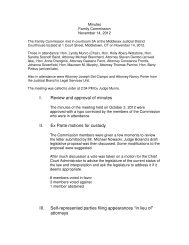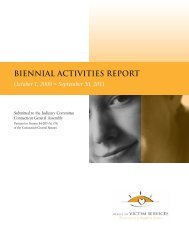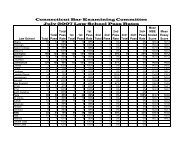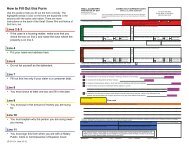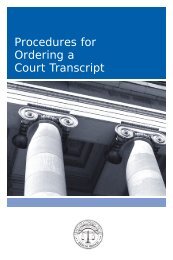December 27, 2007 - Connecticut Judicial Branch - CT.gov
December 27, 2007 - Connecticut Judicial Branch - CT.gov
December 27, 2007 - Connecticut Judicial Branch - CT.gov
Create successful ePaper yourself
Turn your PDF publications into a flip-book with our unique Google optimized e-Paper software.
CSSD Chronicle<br />
A regular publication of information and news about Court Support<br />
Services Division<br />
Please share this with a colleague! Thursday, <strong>December</strong> <strong>27</strong>, <strong>2007</strong> Please share this with a colleague!<br />
JAMS has Arrived<br />
The new <strong>Judicial</strong> Administrative Monitoring System (JAMS) became fully operational as of <strong>December</strong> 21 st , with all<br />
administratively monitored cases now being handled by the new system. With JAMS, supervision of these cases<br />
has been brought “in house” instead of being handled by an outside vendor. “As you read about JAMS” noted<br />
CSSD Executive Director Bill Carbone, “you will see that we have made important changes in the supervision of<br />
administrative level cases. These changes are designed to encourage services that support public safety and free<br />
officers to spend their time on more serious offenders. The development and implementation of JAMS is a result<br />
of the hard work and expertise of our staff and I believe that the system will provide great benefits as we go<br />
forward.”<br />
BACKGROUND: In 1997, prior to the creation of CSSD, a decision was made to use private industry to help monitor<br />
administrative cases. General Security Services Corporation (GSSC) was awarded the contract to establish the<br />
Administrative Monitoring Program. Their bid involved the use of computer software along with a staff of case<br />
workers to monitor court conditions and report back to liaison probation officers if a client was not compliant.<br />
While supervision was enhanced, some problems did occur. Communication between GSSC and the probation<br />
liaison proved to be difficult. Many times a GSSC employee needed a quick answer on a case and couldn’t reach<br />
the liaison officer by telephone in a timely manner (remember this was a time prior to officers having access to e-<br />
mail). GSSC also had to reduce their program staff due to a lower number of administrative probationers than<br />
was originally predicted. This created delays in responding to non compliance.<br />
ADMINISTRATIVE MONITORING IN CSSD: After the creation of CSSD in 1999, Executive Director William<br />
Carbone decided to continue the GSSC program with some significant changes. A full time Adult Probation<br />
Officer was assigned to the GSSC location and quarterly reports were instituted to track contract compliance.<br />
Probation staff at GSSC started working more closely with the non-compliant probationers to prevent their cases<br />
from being returned to the field offices.<br />
With this added oversight, the GSSC Monitoring Program improved in overall effectiveness and the caseload grew<br />
substantially. The effort was seen as a research based approach to the monitoring of low risk probationers. The<br />
basic philosophy behind the Administrative Monitoring Program was probation risk reduction theory and<br />
research that low risk probationers have more successful outcomes with less stringent supervision.<br />
PROBLEMS PERSISTED WITH THE GSSC SYSTEM: However, there were still significant problems with the GSSC<br />
model. For one, officers, bail commissioners and others could not access GSSC notes on a probationer. Phone calls<br />
(or e-mails when available) had to be exchanged to gather information. Secondly, making changes in software or<br />
supervision standards for administrative cases involved rewriting the contract with GSSC which was costly and<br />
time consuming. With the advent of CMIS, and the commitment of CSSD to information based case management,<br />
the desire to incorporate all client related information in one accessible data base became more attractive. It was<br />
determined that the best solution was for CSSD to develop its own software for monitoring administrative cases<br />
that could become part of CMIS.
JAMS UNIT CREATED: In November 2005, a committee was formed to investigate the feasibility of creating<br />
software for CMIS to replace the GSSC model. Representatives from CSSD Information Technology, <strong>Judicial</strong><br />
Information Services, Probation Officers and Softscape (the developer of CMIS) worked on the project. Within<br />
the first year a working model was developed and the JAMS Unit was born. This August, JAMS staff began<br />
migrating cases from the GSSC software into the new system and the field offices began sending new<br />
Administrative cases to the JAMS program. Over the next three months, 8,000 cases were migrated while<br />
hundreds of new cases were entered. As of <strong>December</strong> 21 st , there will no longer be any cases at GSSC. Cases that<br />
were scheduled to end between <strong>December</strong> 21 st and January 31 st will be assigned to Chief Probation Officer I Tom<br />
Kulig who is heading the JAMS project.<br />
IMPROVEMENTS ALREADY SEEN: Although the program is new and officers at the unit are still learning, some<br />
benefits have already been noticed. After a case is entered into JAMS, the software marks due dates for any<br />
verifiable condition. If that date passes and no verifying documentation is received a warning letter is<br />
automatically mailed to the probationer. Depending on the condition, the probationer may receive a second letter<br />
or the unverified condition goes directly to a call list that JAMS’ officers review daily. Towards the end of<br />
probation, if the probationer continues not to supply documentation, the case will go on a queue to notify the field<br />
officer that a case is ending in 120 days with open conditions so that the situation can be addressed before case<br />
closing. Probationers who owe restitution are sent a monthly statement indicating their last payment and their<br />
balance. Those who do not make monthly payments are mailed warning letters. The system also stores AR and new<br />
arrest reports so they can be accessed by field officers as needed.<br />
OR FURTHER INFORMATION ON JAMS contact Tom Kulig, Chief Probation Officer I at 860-548-2008 ext. 323.<br />
Suggestions? Questions? Comments? Concerns? Contact us!<br />
Rena.Goldwasser@jud.ct.<strong>gov</strong>


